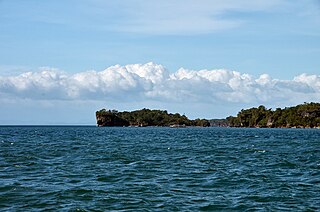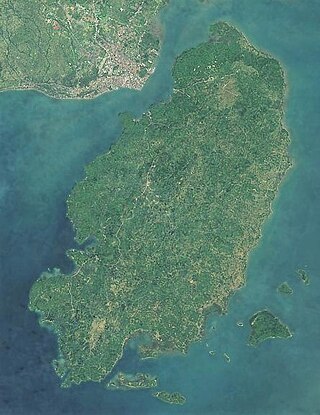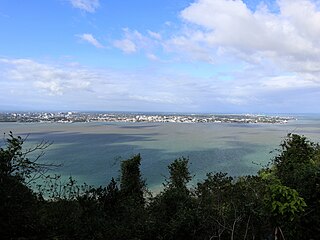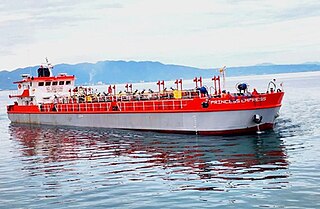
An oil spill is the release of a liquid petroleum hydrocarbon into the environment, especially the marine ecosystem, due to human activity, and is a form of pollution. The term is usually given to marine oil spills, where oil is released into the ocean or coastal waters, but spills may also occur on land. Oil spills may be due to releases of crude oil from tankers, offshore platforms, drilling rigs and wells, as well as spills of refined petroleum products and their by-products, heavier fuels used by large ships such as bunker fuel, or the spill of any oily refuse or waste oil.

Panay Gulf is an extension of the Sulu Sea, reaching between the islands of Panay and Negros in the Philippines. The gulf contains the island-province of Guimaras and extends into the Iloilo Strait, between Panay and Guimaras, and into Guimaras Strait, between Guimaras and Negros. Guimaras Strait connects Panay Gulf with the Visayan Sea.

Guimaras, officially the Province of Guimaras, is an island province in the Philippines located in the Western Visayas region. The capital is Jordan, while the largest local government unit is the municipality of Buenavista. The province is situated in Panay Gulf, between the islands of Panay and Negros. To the northwest is the province of Iloilo and to the southeast is Negros Occidental. The whole island is part of the Metro Iloilo–Guimaras, one of the twelve metropolitan areas of the Philippines.

Western Visayas is an administrative region in the Philippines, numerically designated as Region VI. It consists of six provinces and two highly urbanized cities. The regional center is Iloilo City. The region is dominated by the native speakers of four Visayan languages: Hiligaynon, Kinaray-a, Aklanon and Capiznon. The land area of the region is 20,794.18 km2 (8,028.68 sq mi), and with a population of 7,954,723 inhabitants, it is the second most populous region in the Visayas after Central Visayas.

The Gulf War oil spill, or the "Persian Gulf oil spill", was one of the largest oil spills in history, resulting from the Gulf War in 1991. In January 1991, Iraqi forces allegedly began dumping oil into the Persian Gulf to stop a U.S. coalition-led water landing on their shores. Despite quite high initial estimates, the spill likely was about 4,000,000 US barrels. Within the following months of the spill, most clean-up was targeted at recovering oil, and very little clean-up was done on Saudi Arabia’s highly-affected beaches. An initial study in 1993 found that the spill will not have long-term environmental consequences, but many studies since 1991 have concluded the opposite, claiming that the spill is responsible for environmental damage to coastline sediments and marine species and ecosystems. Considered an act of environmental terrorism, the spill was a heated political move that had implications for the larger Gulf War and temporarily damaged Kuwait and Saudi Arabia.

Nueva Valencia, officially the Municipality of Nueva Valencia, is a 3rd class municipality in the province of Guimaras, Philippines. According to the 2020 census, it has a population of 42,771 people.

The Jiyeh Power Station oil spill is an environmental disaster caused by the release of heavy fuel oil into the eastern Mediterranean after storage tanks at the thermal power station in Jiyeh, Lebanon, 30 km (19 mi) south of Beirut, were bombed by the Israeli Air force on July 14 and July 15, 2006 during the 2006 Israel-Lebanon conflict. The plant's damaged tanks leaked up to 30,000 tonnes of oil into the eastern Mediterranean Sea, A 10 km wide oil slick covered 170 km of coastline, and threatened Turkey and Cyprus. The slick killed fish, threatened the habitat of endangered green sea turtles, and potentially increased the risk of cancer.

The Philippine Nautical Highway System, also the Road Roll-on/Roll-off Terminal System (RRTS) or simply the RoRo System, is an integrated network of highway and vehicular ferry routes which forms the backbone of a nationwide vehicle transport system in the Philippines. It is a system of roads and ports developed by the Philippine government to connect the major islands of Luzon, the Visayas and Mindanao. The 919-kilometer (571 mi) nautical highway was opened to the public on April 12, 2003 as the Strong Republic Nautical Highway (SRNH).

Petron Corporation is the largest oil refining and marketing company in the Philippines, supplying more than a third of the country's oil requirements. It operates a refinery in Limay, Bataan with a rated capacity of 180,000 barrels per day (29,000 m3/d). From the refinery, Petron moves its products mainly by sea to 32 depots and terminals throughout the country.

The Prestige oil spill occurred off the coast of Galicia, Spain in November 2002, caused by the sinking of the 26-year-old, structurally deficient oil tanker MV Prestige, carrying 77,000 tonnes of heavy fuel oil. During a storm, it burst a tank on 13 November, and French, Spanish, and Portuguese governments refused to allow the ship to dock. The vessel subsequently sank on 19 November, about 210 kilometres (130 mi) from the coast of Galicia. It is estimated that it spilled 60,000 tonnes or a volume of 67,000 m3 (17.8 million US gal) of heavy fuel oil.

Metropolitan Iloilo–Guimaras, also shortened as Metro Iloilo–Guimaras or Metro Iloilo, or simply MIG, is a metropolitan area in the Western Visayas in the Philippines. It is situated on the southeastern coast of Panay, including the nearby island province of Guimaras, surrounded by the Iloilo and Guimaras straits.

Igbon Island is an island and barangay in northeastern Iloilo, Philippines. It is part of the municipality of Concepcion. According to the 2010 census, it has a population of 2,547. The island is moderately known in the Philippines for its scuba diving.

The Amoco Cadiz oil spill took place on 16 March 1978, when the oil tanker Amoco Cadiz, owned by the American petroleum company Amoco, ran aground on Portsall Rocks, 2 km (1.2 mi) from the coast of Brittany, France. The vessel ultimately split in three and sank. The US National Oceanic and Atmospheric Administration (NOAA) estimates that the total oil spill amounted to 220,880 tonnes of oil which amounts to over 58 million gallons or 256.2 million litres, making it the largest oil spill of its kind at the time.

The Iloilo Strait is a strait in the Philippines that separates the islands of Panay and Guimaras in the Visayas, and connects Panay Gulf with the Guimaras Strait. It is the location of the Port of Iloilo, the third-busiest of the ports in the Philippines in number of ships. Iloilo City on Panay is the major city located on the strait with Buenavista and Jordan, both on Guimaras, immediately across the strait from the city. The Iloilo River empties into the strait.

Guimaras Strait is a strait in the Western Visayas region of the Philippines, connecting the Visayan Sea with Panay Gulf and the Sulu Sea beyond. To the north and west are Panay and Guimaras Islands, while Negros Island is to the south and east. Bacolod City is a major seaport on the strait, which also provides access to the Port of Iloilo City via the Iloilo Strait.

Taklong Island is the main island of the Taklong Island National Marine Reserve located in Nueva Valencia, Guimaras, off the southern end of the island of Guimaras, in the West Visayas of the Philippines. The island and nearby vicinity was declared by President Corazon Aquino in June 1990. A marine biological station run by the University of the Philippines Visayas (UPV) of nearby Iloilo Province is located on this island. The one-storey station established in 1977 and renovated twice sits on a 1.64 hectares parcel of land donated to UP in 1964, with Carlos P. Romulo as then University President. Donors included the family of the first Lieutenant Governor of then SubProvince of Guimaras, the late Antonio Ortiz. When proclaimed as a national marine reserve in Feb. 8, 1990 by then President Corazon C. Aquino, there was only one family residing in the island, the family of Vicente Basco, the only recognized tenured migrant when Taklong Island became part of the national marine reserve. Mr. Basco was employed by UPV as caretaker of its Station in Taklong Island since the 1970s until his retirement. There are UPV staff, including security guards stationed in the island.
Malingin Island is a small island located in southernmost part of Nueva Valencia, Guimaras in the Philippines, situated beside Unisan Island.
Unisan Island is a small island located in southernmost part of Nueva Valencia, Guimaras and beside Malingin Island in the Philippines. It is the largest island in the Unisan Islets.
The Amazon Venture oil spill occurred at the port of Savannah on the Savannah River in the U.S. state of Georgia. The spill, which occurred from December 4 to 6, 1986, was caused by three defective valves in the piping system of the oil tanker MV Amazon Venture, which leaked approximately 500,000 US gallons of fuel oil into the river.

On the morning of February 28, 2023, MT Princess Empress sank off Naujan, Oriental Mindoro, Philippines, causing an oil spill in the waters of the provinces of Antique, Batangas, Oriental Mindoro, and Palawan. En route from Bataan to Iloilo, the oil tanker was carrying 900,000 liters of industrial fuel oil before it sank.




















